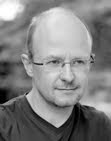
I just received a copy of a recently published
photobook on Mongolia: "Mongolie - Vie nomades en images et en sons" by French photographer Samuel Keller (Acted Sud, 2005). I was fortunate enough to be able to visit this country a few times in the context of a professional assignment. I have a few friends there. And it is the place where this crazy infatuation with photography
finally took shape. So I'm always keen to add interesting new (photo)books on this country to my library.
Over the past years there have been quite a few new publications. Apparently it is primarily French photographers who find their way to this Central-Asian enclave:
Michel Setboun,
Patrick Bard,
Frédéric Hermann. And now we have Samuel Keller. All of them explore the three quintessentially Mongolian habitats: the capital city Ulaanbataar, the steppes and (what is left of) the monestaries.
Despite the modest size of his book (16 x 23 cm) Patrick Bard is the one that has penetrated most deeply the spirit of this country, both in words and images. The text, written by the photographer himself (he is an accomplished novelist too), is a very good introduction to Mongolian history, culture and places. His pictures (b&w) are strong and edgy. It is classic reportage photography but of a very high standard. Amongst the many memorable images, I would single out the final one. It is a picture taken at daybreak on the summit of an extinghuished volcano, Shilliin Bogd, in the deep southeast of the country very close to the Chinese border. It is the wish of many Mongolians to undertake a pilgrimage to this place once in their life. The atmosphere on the summit is superbly captured: there is light, a sense of space, of movement and of mystery. Apart from the quality of the pictures, I commend the straightforward but tasteful layout of the book.
Setboun is an independent photographer with a long track record in classical reportage for glossy travel and current affairs magazines. His "Mongolie - Rêve d'Infinie" has been conceived in the conventional coffeetable book mould: colour photography, big book, conventional layout ... . Given the size of the book, the photography is, inevitably, a bit uneven. But I wouldn't want to be without it. Setboun's pictures have a very distinctive look. What strikes is the very prominent but very attractive grain. And then there is the colour palette: very vivid oranges, reds, deep blues and greens, but very soft and earthy greys, browns, yellows and ochres. It looks pleasingly old-fashioned. On top of that there are certainly quite a few imaginative photographs scattered over the book's 200 pages.
I haven't seen Hermann's book on Mongolia, but I have his other volumes on the Transsiberia Express and on Central Asia. I assume there is a certain overlap. Hermann works both in colour and b&w, with the latter making the strongest impression. But I clearly prefer Bard who is purer, leaner and without some of Hermann's irritating tics (such as holding the camera at an angle).
The Keller booklet, finally, is not the strongest from the bunch. It is a neat collection of 50 b&w, square format (always nice!) photos, but despite a couple of quite strong images it makes a rather shallow and haphazard impression. In my opinion, the photographer does not exhibit the same degree of familiarity with his subject as do Bard and Setboun. However, interestingly enough, the book comes with a cd. It features Keller's roadside recordings of Mongolian sounds and songs. Re-hearing the monotonous calls of vendors, the chatter of children playing and the traditional songs evoked powerful memories for me. So all in all I am not unhappy with this book.
Finally, I would like to draw attention to an excellent
Mongolia book that has recently been published by Belgian (Flemish) photographer Jan Locus. I know Jan personally and this book has been a real labour of love for many years. His portfolio surveys a mix of traditional (UB, Nadaam) and less familiar locales (military barracks, prisons, coal mines, street children). Locus works within the constraints of the square format with a variety of tools: Hasselblad with an 80mm, a Mamiya 6 and a Diana toy camera. The book has a very special mood and I find it difficult to put the finger exactly on what is so distinctive about it. There is a gritty, epic quality to the pictures that I like very much. We are far removed from the romantic celebration of nomadic pastoralism that seems to be the subtext of most Mongolia books (including those discussed above). At the same time, by exploiting the luscious out-of-focus rendering of his Zeiss optics (and the rather less opulent bokeh of the plastic Diana lens), Locus is able to evoke a dreamy, sometimes surreal atmosphere. I suppose it is the tension between these two elements that continues to fascinate us in these pictures. By the way, no effort has been spared in the production of this book: 600 line quadtone by a specialist Belgian printing house Salto2.
I took the picture accompanying this post with a Horizon 202 panorama camera at central Sukhbataar Square in Ulaanbataar, January 2002.
 This morning I went to the famous site of the Waterloo battle. In June 1815 this was the scene of indescribable carnage as Napoleon's army collided with the allied Anglo-Dutch and Prussian forces. Now there is a famous monument - the "Butte du Lion" - which towers above the undulating fields.
This morning I went to the famous site of the Waterloo battle. In June 1815 this was the scene of indescribable carnage as Napoleon's army collided with the allied Anglo-Dutch and Prussian forces. Now there is a famous monument - the "Butte du Lion" - which towers above the undulating fields.







